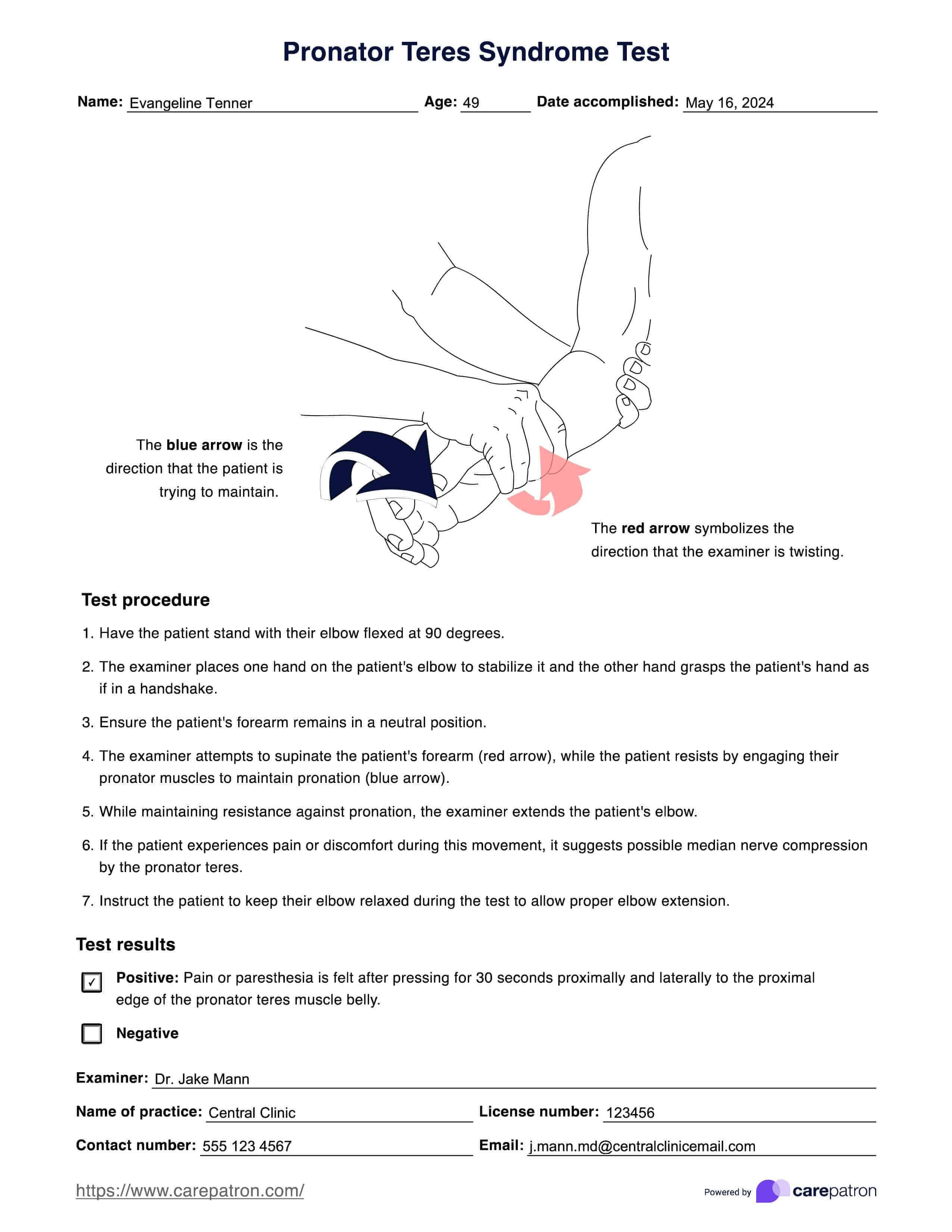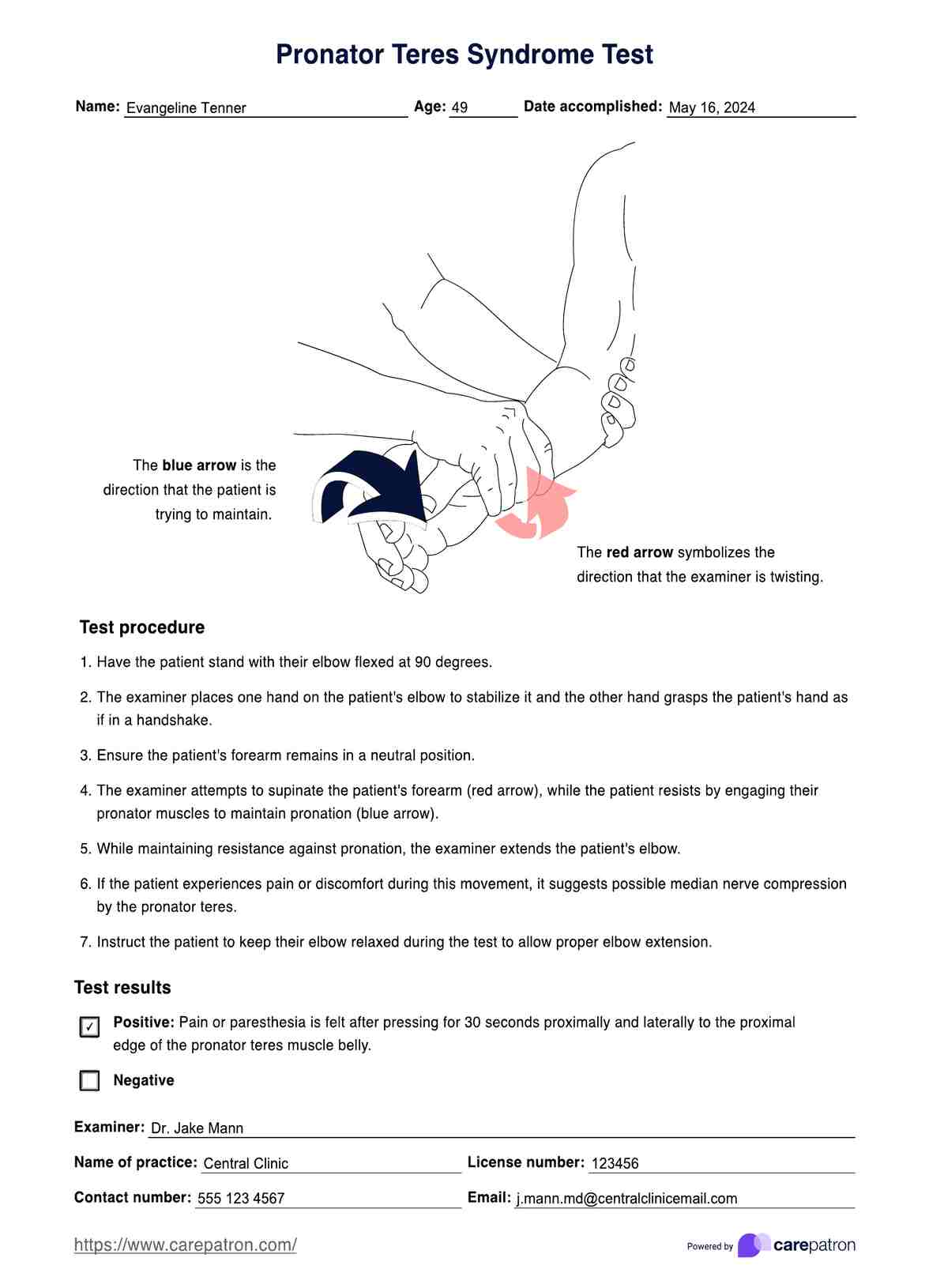Pronator Teres Syndrome Test
Master the Pronator Teres Syndrome Test to diagnose nerve compression & distinguish it from carpal tunnel. Improve patient outcomes!


What is pronator teres syndrome?
Pronator teres syndrome (PTS) is a nerve entrapment condition where the pronator teres muscle in the forearm compresses the median nerve. This compression leads to symptoms that resemble carpal tunnel syndrome but are distinct due to their specific location and effects on the forearm and hand.
Other contributing factors include swollen or inflamed tissue or scar tissue within the forearm muscles. Individuals engaged in repetitive and strenuous forearm and wrist movements, such as tennis, squash, racquetball, and manual labor like carpentry, are at increased risk. Additional risk factors include poor physical conditioning, inadequate warm-up before activities, and certain medical conditions like diabetes mellitus and hypothyroidism.
The symptoms include forearm pain, especially with gripping activities, and tingling, numbness, or burning sensations in the thumb and first three fingers. Weakness in the middle finger or hand, difficulty with delicate motor tasks, and forearm fatigue are common. Symptoms may also include aching pain in the forearm, exacerbated by repetitive forearm pronation and supination.
Treatment options include non-surgical and surgical approaches. Non-surgical treatment focuses on rest, avoiding aggravating activities, using nonsteroidal anti-inflammatory drugs (NSAIDs), physical therapy exercises, cold therapy, and heat therapy.
If conservative treatments do not provide relief, surgery may be necessary to alleviate the pressure on the median nerve. Preventive measures include proper warm-up and stretching before activities, maintaining good physical conditioning with an emphasis on forearm, index finger, and wrist strength and flexibility, and using appropriate techniques and ergonomics to reduce strain.
With appropriate treatment, it is usually manageable, and many individuals recover fully without needing surgery. If surgery is required, it often results in significant symptom relief and improved function.
How does it differ from carpal tunnel syndrome?
Pronator teres syndrome (PTS) occurs in the forearm by the pronator teres muscle near the elbow, while carpal tunnel syndrome (CTS) occurs in the wrist within the carpal tunnel. Both conditions have similar symptoms in the form of tingling and numbness, but PTS leads to forearm pain, thumb weakness, and fine motor difficulty, whereas CTS symptoms include hand weakness, dropping objects, and symptoms often worse at night. Repetitive forearm movements and conditions like diabetes can cause PTS, while repetitive wrist movements, injuries, arthritis, pregnancy, and diabetes can lead to CTS.
Treatment for both PTS and CTS includes NSAIDs, physical therapy, and possibly surgery. However, rest and avoiding aggravating activities are particularly beneficial for PTS, whereas CTS often requires splints and corticosteroid injections, which are not typically used for PTS. Preventive measures also differ: PTS prevention focuses on warm-up, stretching, good conditioning, and proper techniques, while CTS prevention includes ergonomic adjustments, frequent breaks, wrist exercises, and maintaining hand and wrist health.
How to diagnose a pronator teres syndrome?
Diagnosing pronator teres syndrome involves several steps, including a thorough medical history, a physical exam and examination, and specific diagnostic tests:
- Review the patient's symptoms, onset, worsening activities, repetitive movements, and underlying medical conditions.
- Palpate the forearm muscles for tenderness or swelling, check muscle strength, compare both forearms, examine hand and finger function, and observe for muscle atrophy or changes in skin sensitivity.
- Perform the PTS test.
PTS can mimic other conditions affecting the hand and forearm. The physical examinations and specific diagnostic tests below are employed for an accurate diagnosis:
- Pronator compression test: Pressure on pronator teres, with resisted pronation. Symptoms suggest pronator teres syndrome.
- Tinel's sign: Tap over the median nerve at the pronator teres, eliciting tingling in the thumb and first three fingers, which indicates a positive test.
- Resisted pronation with elbow flexion: Flex elbow to 90 degrees, pronate against resistance. Pain suggests pronator teres syndrome.
- Nerve conduction and electromyography (EMG): These tests measure the electrical activity of muscles and the speed of nerve signals to detect abnormalities in the median nerve function.
Pronator Teres Syndrome Test Template
Pronator Teres Syndrome Test Example
What is the Pronator Teres Syndrome Test?
The Pronator Teres Syndrome Test is crucial for distinguishing between the pronator muscle teres syndrome and carpal tunnel syndrome. This test evaluates median nerve compression caused by the pronator teres muscle. Patients with forearm pain and muscle weakness in the thenar eminence should be assessed for pronator syndrome.
During the test, resistance against forearm pronation can reveal symptoms of nerve compression at the medial epicondyle. Accurate diagnosis is essential, as conservative treatment like physical therapy or surgical decompression may be required based on the severity of symptoms.
Early identification and treatment options such as anti-inflammatory medications and physical therapy can significantly improve outcomes for most patients experiencing forearm pain and muscle weakness due to pronator teres syndrome.
How to conduct the Pronator Teres Syndrome Test
The Pronator Teres Syndrome Test helps healthcare professionals assess for potential compression of the median nerve by the pronator teres muscle in the forearm. Here's how it's conducted:
- The patient should sit comfortably with the elbow flexed to 90 degrees and the forearm in a neutral position (halfway between pronation and supination).
- Places one hand on the patient's elbow crease, stabilizing it. The other hand grasps the patient's hand, holding it in a handshake position.
- Ask the patient to pronate their forearm (turning the palm downward) against resistance. At the same time, attempt to induce forearm supination so that resistance is applied while extending the patient’s elbow.
A positive test for pronator teres syndrome is indicated by pain or discomfort in the upper forearm and tingling or numbness in the thumb, index, and middle fingers.
Benefits of using our template
Understanding and effectively managing pronator syndrome can feel overwhelming. Our template simplifies the process, equipping you with the knowledge and tools to regain control of your health.
Here's how our template benefits you:
- Comprehensive guidance: The template offers detailed instructions with for conducting the Pronator Teres Syndrome Test, ensuring accurate diagnosis and consistent application across different healthcare providers.
- Time efficiency: Using the template streamlines the testing process, saving time for healthcare professionals by providing a structured and easy-to-follow format.
- Improved patient outcomes: By facilitating early and accurate diagnosis through a standardized testing approach, the Carepatron template contributes to better patient management and outcomes.
Treatment options for pronator teres syndrome
Here are some common treatment options for PTS:
- Avoid activities that worsen symptoms, such as repetitive turning or twisting movements with the arm. Rest the arm and use a splint or brace, especially at night, to reduce swelling and irritation of the median nerve.
- Medications such as ibuprofen, naproxen, and local steroid injections can help reduce pain and inflammation.
- Perform exercises to stretch and strengthen forearm muscles, improve posture, and enhance ergonomics to support median nerve mobility.
- Modify workstations and tools to minimize repetitive strain on the forearm and wrist. Ensure proper positioning and support during activities.
- Consider techniques such as acupuncture or chiropractic adjustments to relieve symptoms.
- In severe or persistent cases, surgery may be necessary to release the compression on the median nerve. This is usually considered when conservative treatments have failed to provide relief.
When should a patient be referred to a specialist for PTS?
A specialist referral is necessary if non-surgical treatments such as physical therapy, anti-inflammatory medications, or activity modifications do not alleviate symptoms. This includes addressing compressive neuropathy and evaluating the effectiveness of treatments.
Also, when patients report nocturnal symptoms similar to Carpal Tunnel Syndrome (CTS) but affecting the median nerve (MN) distribution more proximally, there is a need for specialist intervention to differentiate between PTS and CTS. Noticeable motor function impairment, especially in the thenar muscles, or the presence of thenar atrophy, indicates significant MN compression that warrants specialist evaluation.
Suppose symptoms are suspected to originate from specific compression sites, such as the ulnar and humeral heads, bicipital aponeurosis, or the superficial head of the pronator teres muscle. In that case, specialist assessment can help pinpoint the exact location and severity of the compression. Bony abnormalities or the presence of an anatomical variant like Gantzer’s muscle can contribute to MN compression as well.
When symptoms resemble those of anterior interosseous nerve (AIN) syndrome or other similar conditions, a specialist can provide a differential diagnosis to ensure appropriate treatment.
Commonly asked questions
The Pronator Teres Syndrome Test involves the patient pronating their forearm against resistance while the examiner extends the elbow. A positive test is indicated by pain in the proximal forearm and tingling in the median nerve distribution.
Symptoms include tingling, numbness, or burning in the thumb and first three fingers, forearm pain, hand weakness, and difficulty with grip strength. Symptoms often worsen with repetitive forearm movements.
Pronator teres syndrome causes forearm pain and symptoms that worsen with forearm pronation. In contrast, carpal tunnel syndrome typically involves wrist pain and symptoms that worsen at night and with wrist flexion







































































































